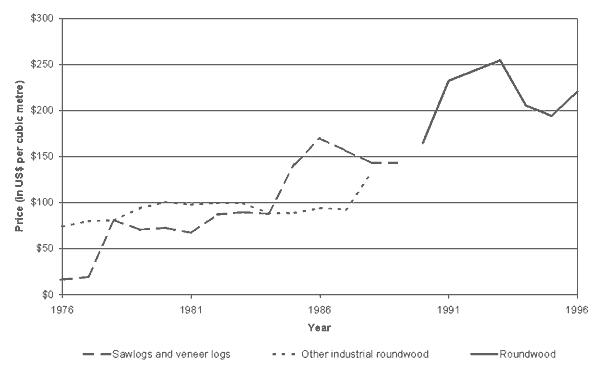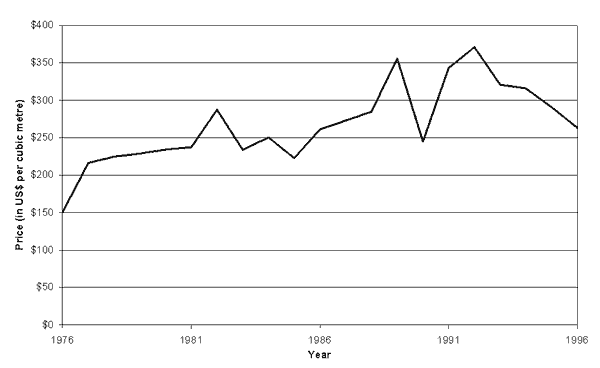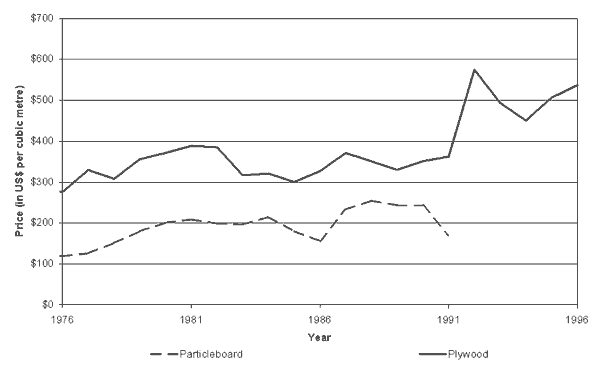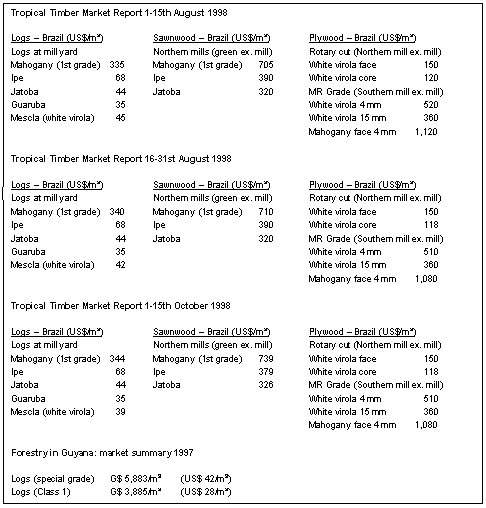


data collected from international sources
In addition to the data collected in Suriname, some data on costs and prices was also collected from international sources for this analysis. Sources used included: statistical reports and publications; manufacturer's and retailer's handbooks and catalogues; and Internet resources. Full details of potential data sources are given in Appendix 1.
Two types of cost information were collected from international sources: the cost of consumable items that can not usually be purchased in Suriname, but have to be imported from foreign suppliers; and the cost of capital equipment (which is always imported, either directly or through a local distributor, such as Surmac). In addition to this, information about tariffs was also collected from the Internet.
Consumable costs
Information about the cost of consumable items that can not be readily obtained in Suriname, were collected from the Forestry Suppliers Inc. catalogue for 1998 (Forestry Suppliers Inc., 1998). This catalogue contains a vast amount of information about general forestry items, such as small tools, clothing, safety equipment and other minor items of forestry equipment. The data collected similar to that shown in Table 6.
Capital costs
Information about the cost of various large items of forestry equipment, such as: skidders; bulldozers; trucks; and loaders, were collected from the Internet. A large Internet site containing a lot of information about the cost of these sorts of items can be found at: www.tms-sales.com (TMS Machinery Sales). Other sites giving new and second-hand price information include: www.madillequipment.com (Madill Equipment Inc.); www.equipmentsearch.com; and www.gsnet.com/servlet (Pape Group Caterpillar Dealers). All of these sites only contain information about sale prices in North America. However, they can be used to estimate depreciation rates for machinery and, thus, be used to derive second-hand values from the cost of new machinery in Suriname. A selection of the data collected on capital equipment prices is given in Table 49 to Table 52 below.
Table 49 Prices of new and second-hand logging trucks in North America in 1998
|
Make and model |
Price (in thousand US$) |
Age of machinery (in years) |
|
Western Star |
102.950 |
new |
|
Western Star |
92.500 |
new |
|
Western Star |
90.450 |
new |
|
Western Star |
77.500 |
1 |
|
Western Star |
43.980 |
3 |
|
Western Star + trailer |
69.750 |
4 |
|
Volvo Intergenel (self loader) + trailer |
52.000 |
8 |
|
Western Star |
29.750 |
8 |
|
Western Star (selfloader) + trailer |
74.950 |
9 |
|
Western Star (selfloader) |
69.500 |
9 |
|
Mack 300 (self loader) + trailer |
26.500 |
9 |
|
Freightliner + trailer |
16.000 |
9 |
|
Brigadeer (self loader) + trailer |
36.500 |
13 |
|
Kenilworth |
29.750 |
14 |
|
Chevrolet C70 + trailer |
6.750 |
17 |
|
International S1700 + trailer |
13.900 |
18 |
|
Chevrolet C65 + trailer |
2.500 |
23 |
|
Mack R685LS + trailer |
1.500 |
30 |
Source: Various internet sources
Table 50 Prices of second-hand forest loaders in North America in 1998
|
Make and model |
Price (in thousand US$) |
Age of machinery (in years) |
|
Caterpillar 322 LL |
199.500 |
1 |
|
Log Hog 920 |
60.000 |
2 |
|
Caterpillar 950F II |
149.500 |
3 |
|
Caterpillar 990 |
46.765 |
3 |
|
Caterpillar 926E |
55.000 |
4 |
|
Thunderbird L840 |
125.300 |
5 |
|
Barko 160A |
47.250 |
5 |
|
Caterpillar 966C |
78.000 |
6 |
|
Prentice 325 |
47.300 |
7 |
|
Prentice 210C |
37.500 |
9 |
|
Log Hog 860 |
18.000 |
9 |
|
Prentice D625CA |
99.500 |
10 |
|
Caterpillar 229 |
52.650 |
10 |
|
Caterpillar 926E |
44.000 |
10 |
|
Caterpillar 950E |
37.000 |
11 |
|
Caterpillar 936 |
57.500 |
13 |
|
Caterpillar 936 |
59.500 |
14 |
|
Caterpillar 225 |
37.500 |
14 |
|
Caterpillar 950 |
38.000 |
20 |
|
Caterpillar 225 |
41.200 |
21 |
|
Caterpillar 966 |
38.900 |
22 |
|
Caterpillar 966 C |
37.500 |
25 |
|
Caterpillar 966 C |
32.000 |
25 |
|
Caterpillar 966C |
28.500 |
29 |
|
Caterpillar 950 |
17.500 |
30 |
Source: Various internet sources
Table 51 Prices of second-hand skidders in North America in 1998
|
Make and model |
Price (in thousand US$) |
Age of machinery (in years) |
|
Caterpillar 515 |
118.500 |
2 |
|
Caterpillar 515 |
110.000 |
2 |
|
Caterpillar 525 |
169.500 |
3 |
|
Timberjack 1210 |
166.391 |
3 |
|
Timberjack 450C |
72.000 |
3 |
|
Ranger G67 |
39.000 |
4 |
|
John Deere 548E |
69.000 |
5 |
|
Caterpillar 518 |
68.500 |
6 |
|
Timberjack 480B |
65.000 |
6 |
|
Caterpillar 518 |
38.500 |
6 |
|
Caterpillar 518 |
34.500 |
7 |
|
John Deere 548D |
35.560 |
8 |
|
Clark 668 |
39.000 |
9 |
|
Tree Farmer C5D |
32.500 |
9 |
|
Caterpillar 518 |
85.300 |
10 |
|
Caterpillar 518 |
59.500 |
10 |
|
Caterpillar 518 |
52.650 |
10 |
|
John Deere 648 |
42.000 |
10 |
|
MRS SK100 |
25.000 |
10 |
|
Franklin 170-453 |
37.780 |
11 |
|
Caterpillar 518 |
35.000 |
11 |
|
Caterpillar 518 |
59.500 |
12 |
|
Timberjack 230D |
32.985 |
12 |
|
Caterpillar 518 |
28.000 |
12 |
|
Caterpillar 518 |
66.000 |
13 |
|
Grapple 380 |
30.000 |
13 |
|
Caterpillar 518 |
25.000 |
13 |
|
Caterpillar 518 |
47.500 |
14 |
|
Taylor TS140 |
19.000 |
15 |
|
John Deere 640 |
28.000 |
17 |
|
Caterpillar 518 |
34.000 |
18 |
|
Caterpillar 518 |
19.500 |
18 |
|
Caterpillar 518 |
18.000 |
18 |
|
Husky 240 |
16.126 |
18 |
|
Timberjack 350 |
13.927 |
18 |
|
Caterpillar 518 |
36.500 |
19 |
|
John Deere 640 |
31.200 |
19 |
|
Caterpillar 528 |
42.500 |
20 |
|
Clark 664B |
12.461 |
24 |
|
Timberjack 230 |
12.000 |
26 |
Source: Various internet sources
Table 52 Prices of second-hand bulldozers in North America in 1998
|
Make and model |
Price (in thousand US$) |
Age of machinery (in years) |
|
Caterpillar D8N |
269.500 |
3 |
|
Caterpillar D6H XLR |
115.000 |
4 |
|
Caterpillar D6H |
149.500 |
8 |
|
Caterpillar D8N |
237.000 |
9 |
|
Caterpillar D6H |
76.500 |
11 |
|
Caterpillar D8K |
89.500 |
17 |
|
Caterpillar D8K |
87.500 |
18 |
|
Caterpillar D8K |
49.000 |
18 |
|
Caterpillar D6D |
64.900 |
19 |
|
Caterpillar D6D |
52.650 |
19 |
|
Caterpillar D6D |
52.650 |
19 |
|
Caterpillar D8K |
76.500 |
20 |
|
Caterpillar D6D |
57.500 |
20 |
|
Caterpillar D6C |
36.500 |
22 |
|
Caterpillar D6C |
35.300 |
30 |
|
Caterpillar D6C |
17.900 |
34 |
Source: Various internet sources
Other miscellaneous costs
In order to try to account for the large difference between the USA list prices of harvesting machinery and the prices quoted in Suriname, the import tariffs for Suriname were obtained from the Tradeport trade directory ( http://tradeport.org/ts/countries/suriname/regs.shtml). Average import duties for most goods entering Suriname are between 30% and 40%. In addition to this, a consent right and statistical right of 0.5% each also have to be paid on all imports. This would account for some of the apparent 50% to 70% mark-up on the price of harvesting machinery sold in Suriname.
Manufacturer's estimates of rates of materials consumption and productivity
Estimates of materials consumption, productivity and repair requirements were taken from the Caterpillar Handbook for 1996 (Caterpillar, 1996). Although a few pieces of machinery from other manufacturers are currently being used in the forestry sector, it is likely that this information will be broadly representative of the rates of materials consumption, productivity and repair requirements of this other machinery as well.
Estimates of the expected consumption of fuel, greases, oils and other lubricants (e.g. hydraulic fluids and transmission lubricants) are given in Table 53.
Table 53 Materials consumption for main pieces of harvesting machinery (in litres per working hour)
|
Type of machinery |
Material |
||||||||
|
Fuel |
Oils |
Grease |
Other |
||||||
|
Type |
(amount) |
lubricants |
|||||||
|
Chainsaw |
petrol |
3.00 |
2.50 |
0.25 |
0.25 |
||||
|
Bulldozer (D6) |
diesel |
25.00 |
0.25 |
0.02 |
0.04 |
||||
|
Skidder |
diesel |
20.00 |
0.13 |
0.02 |
0.08 |
||||
|
Loader |
diesel |
20.00 |
0.11 |
0.01 |
0.05 |
||||
|
Logging truck |
diesel |
30.00 |
0.30 |
0.02 |
0.02 |
||||
|
Barge |
diesel |
50.00 |
0.50 |
0.05 |
0.02 |
||||
|
Bulldozer (D8) |
diesel |
35.00 |
0.27 |
0.02 |
0.05 |
||||
Source: Caterpillar (1996) and author's own estimates
The Caterpillar Handbook also gives various formulae for producing machine productivity rates. These rates can differ widely depending upon terrain, type of work, age and maintenance of the machine, the skills of the operator and the overall management of the work being performed. As noted above, productivity rates in Suriname are very low for a number of reasons, so it would not be appropriate to use the rates given in the Caterpillar Handbook in the cost analysis. They can be used however, as an indication of the current level of efficiency in the forestry sector.
The other important piece of information given in the Caterpillar Handbook is the repair reserve. This is an estimate of the cost of repairs that are likely for each piece of machinery under various working conditions. Although this is based on working trials carried-out by Caterpillar and is mainly a planning tool, this information is not readily available in Suriname and these estimates can be used as working assumptions for the calculation of economic rent. The repair reserves quoted in the Caterpillar Handbook are given in Table 54. These have to be adjusted to reflect the local cost of labour and spare parts and the age of machinery currently being used in Suriname. In order to do this, the Handbook also quotes the cost of labour used in these calculations (US$ 50 per hour) and the proportion of the total cost accounted for by labour costs.
Table 54 Estimated cost of repairs (repair reserve) (in US$ per working hour)
|
Machine |
Repair reserve quoted in the Caterpillar Handbook (in US$ per hour) |
Labour cost as a proportion of the |
|||
|
Low |
Medium |
High |
total repair cost |
||
|
Caterpillar D6 (skidding bulldozer) |
3.50 |
4.50 |
6.50 |
40% |
|
|
Caterpillar D8 (road construction bulldozer) |
5.00 |
8.00 |
9.50 |
30% |
|
|
Caterpillar 528 (wheeled skidder) |
4.50 |
6.00 |
8.00 |
45% |
|
|
Caterpillar 527 (tracked skidder) |
3.55 |
4.75 |
6.55 |
45% |
|
|
Caterpillar 928 (wheeled loader - 4t capacity) |
2.75 |
3.75 |
5.00 |
40% |
|
|
Caterpillar 950 (wheeled loader - 5t capacity) |
4.25 |
5.00 |
7.00 |
40% |
|
Source: Caterpillar (1996)
Price information was collected from two main international sources: FAO and the International Tropical Timber Organisation (ITTO). Most of the price information collected by these two organisations is international trade price information (which is generally easier to collect). However, the ITTO and Joint FAO/UNECE office in Geneva do also produce a little domestic market price information. Comprehensive national sources of information (outside Suriname) include the Malaysian Timber Council (MTC) and the Forestry Commission of Guyana.
Trade values for Suriname
The statistics on timber trade are presented by the FAO in their Yearbook of Forest Products (FAO, 1998 - also available on CD-ROM and at the FAO Website). These show trade by volume and by value and, by dividing one by the other, it is possible to calculate average trade prices for broad product aggregates (e.g. sawnwood or plywood). Figure 6 to Figure 8 show export prices derived from the FAO trade data in this way, for the years 1976 to 1996.
The trade data presented by FAO is taken from questionnaires about forest products production and trade, that are completed by countries each year. Many countries reply only partially to this questionnaire and FAO have to fill-in the missing data using data that has been supplied by national customs authorities to the UN Statistical Office. The replies to these questionnaires are also validated (e.g. if on country says it exports a certain amount to another, this is checked with the other country's statement about imports). In this way, these statistics are adjusted to overcome some of the problems of mis-classification and mis-representation that occur where timber traders attempt to get around trade restrictions and tariffs.
The prices shown in Figure 6 to Figure 8, are higher than those recorded in Suriname, suggesting that there may be some under-reporting of export values in Suriname (this is particularly likely in view of the way in which log export royalties are calculated). However, they may also be slightly on the high side, if they have been validated using import statistics for other countries (which would tend to include the cost of transport and insurance).
In conclusion, after taking into account freight and insurance costs, it would seem likely that the average true export price of forest products from Suriname might be in the order of: US$ 125/m3 to US$ 175/m3 for roundwood; US$ 225/m3 to US$ 300/m3 for sawnwood; and US$ 350/m3 to US$ 450/m3 for plywood. These figures would be more in line with general international trading prices for these types of forest products.
A feature that will be made available in late 1999 is direct access (over the Internet) to the bilateral trade statistics (collected by national customs authorities and collated by the UN Statistical Office). This will make it much easier to check the validity of export prices stated by forest product exporters in Suriname (e.g. the stated value of sawnwood exported to the Netherlands can be checked against the Dutch import statistics for sawnwood imported from Suriname into the Netherlands).
 Figure 6 The price of roundwood exported from Suriname 1976 - 96
Figure 6 The price of roundwood exported from Suriname 1976 - 96
Source: FAO (1998)
 Figure 7 The price of sawnwood exported from Suriname 1976 - 96
Figure 7 The price of sawnwood exported from Suriname 1976 - 96
Source: FAO (1998)
 Figure 8 The price of wood based panels exported from Suriname 1976 - 96
Figure 8 The price of wood based panels exported from Suriname 1976 - 96
Source: FAO (1998)
Domestic prices for neighbouring countries
Of all the neighbouring countries, the most accessible information about domestic timber prices is available for Brazil and Guyana. ITTO, in their Tropical Timber Market Reports, produce regular information about Brazilian log, sawnwood and plywood prices and occasionally produce information about forest product prices in Guyana. A comprehensive time-series of price information for Brazil is also produced in the ITTO Annual Review (ITTO, 1998) and the Guyana Forestry Commission have started to produce annual timber market reports (GFC, 1998). A selection of data from these sources is presented below.
Box 6 Examples of domestic price data available from the ITTO and GFC

Tropical Timber Market Report 1-15th August 1998
Source: ITTO and GFC (1998)
Trade prices for neighbouring countries
Trade prices for Guyana and Brazil can also be obtained from the ITTO and the Guyana Forestry Commission, from the same sources. A selection of this information is presented below. In addition to this, as with the Suriname trade prices shown earlier, the FAO Yearbook of Forest Products can also be used to derive trade prices for all major product categories in all countries. However, it should be noted that trends in prices derived from FAO data may reflect changes within the product category (e.g. there are many different types and grades of sawnwood included in the sawnwood category), rather than true changes in prices.
Box 7 Examples of trade price data available from the ITTO and GFC

Source: ITTO and GFC (1998)